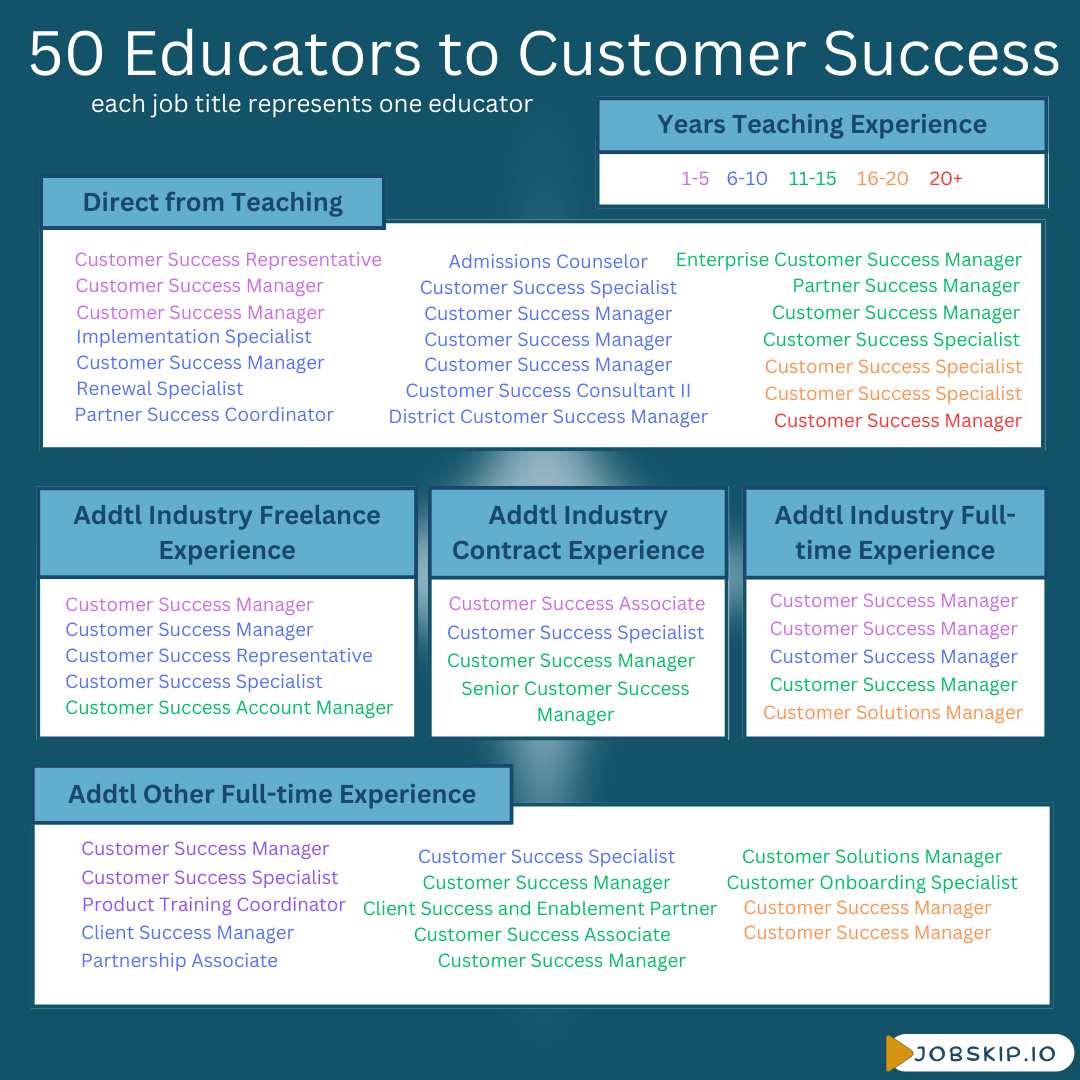“Educators have a very hard time transitioning to Customer Success. Even in Edtech.”
I heard this recently from someone senior in the field with a lot of experience working with career transitioners, including educators.
And I think they’re wrong.
But at the time I didn’t have a lot of data to back it up beyond my own sense of, “I know a ton of educators who have transitioned. It’s one of the more common job skips!”
But that’s just anecdata and certainly didn’t persuade the person I was talking to!
So here’s some actual data around 50 educators who moved into customer success from 2021-2023!
I hope this will give you hope that your edskip is possible as well as give you some specific strategies to apply more competitively to Customer Success jobs.
~ Chelsea
Table of Contents
- What experience do educators need to skip to Customer Success?
- How to prepare your resume for Customer Success jobs
- Resources for your Customer Success Job Skip:
- Industry thought leaders to follow on LI
- The best articles or LinkedIn posts on Customer Success
- The top Customer Success books & podcasts for in-depth learning
What Experience do Educators Need to Skip to Customer Success Jobs?
In previous newsletters, I’ve explored the Educator to Customer Success journey and talked about how most successful edskippers had some combination of team leadership or admin experience. But the job market is rapidly changing, so I wanted to explore who’s getting jobs in CS right now directly from teaching positions.
Methodology
I sourced the names of 50 former teachers who are now working in Customer Success and started their new job between 2021-2023. All of the educators went directly from a full-time job teaching to a full-time job in Customer Success.
I sourced people who showed up in my LinkedIn feed with a ‘new job celebration’ and (because I only had 37 names!), I searched LinkedIn for former teachers now working in Customer Success. I relied on their LinkedIn profiles for information about their work experience. I didn’t report information about the types of industries educators moved into because I was originally tracking educators who moved into edtech and only later broadened my search to all industries.

Results of Reviewing 50 LinkedIn Profiles
As you can see from the chart I included above, there was a good mix between educators who moved directly from teaching without any other experience and those who had other experience.
Most of that ‘other’ experience was not related to Customer Success — but likely helped those teachers translate their skills to a business context because they’d worked in that environment previously.
For educators who had previous industry experience, their full-time experience was usually directly related to Customer Success (sales, customer success, or corporate training), though not necessarily in edtech. Part-time industry experience was more varied suggesting that the value there came from understanding how edtech works and building networking connections in the industry.
But a significant number of educators who had ‘other’ full-time or freelance experience had an unrelated career path before coming to teaching or worked local summer jobs.
Educators not only can but frequently do move into Customer Success without needing any specific experience.
And that includes boot camps or special programs. Only one educator out of these 50 participated in an industry-specific bootcamp.
What happens when these CSMs become former teachers?
One trend I quickly noticed while processing and cleaning my data (yes, I’m taking a data analytics course!) was that a lot of people I flagged back in 2021 as moving into Customer Success are now working in a different position or at a different company.
In fact, out of these 50 people, 25% moved to a new company or were promoted within their first 6 months to 2 years. (Strong caveat to this data: many of the candidates I sourced haven’t been working at their current job long enough to be promoted. So this is a definite undercount!)
And some interesting stats:
*I wondered if start-up companies might hire people with more experience but they didn’t — in fact, companies of all sizes hired teachers direct from teaching and with additional experience at largely the same rates.
*Titles don’t necessarily correspond to job levels — in fact, it’s impossible to tell if some of these jobs are entry-level or not. (And heaven help us if we’re creating search alerts with them!)
Bullet Points and Customer Success
Customer Success is a data-driven field: every single interaction is quantified and geared towards ensuring the customer will have a positive enough interaction with the product to renew. But it’s also very relationship-driven because you have to be able to not just figure out how to solve a customer’s problem but build a connection with them that enables you to discover their problems and get them to invest the time into solving them with you.
That means Customer Success resumes hit the two biggest challenges I see teachers struggle with as they translate their resumes: lack of metrics and how to share soft skills.
In The Edskipper, we talk frequently about how to align our educator experience so that it authentically shows our aligned skills. When you’re applying to Customer Success jobs, here are a few suggestions for how to do that:
- share your workflows around creating IEPs or differentiating curriculum (things like: objectives, timelines and milestones, evaluation criteria, etc.)
- share your data workflows (things like: how you monitor student progress, how frequently you monitor progress, how you evaluate progress, etc.)
- share your workflows for interacting with others (things like: how you onboard new families, your process for proactively reaching out when there are classroom challenges, how you collaborate with teachers and admin and contractors, etc.)
- find some quantifiable metrics (things like: increasing parent engagement, pilot program results, student growth from fall to spring, etc.)
While some of these workflows apply to many job categories outside of teaching, knowing the right workflows to emphasize is important. You aren’t just documenting what you did as a teacher, you’re aligning what you did as a teacher with what you’ll do in your next job.
This is tough work but it’s also do-able. But practice — and feedback from people who know the industry — is important.
Your resume (and LinkedIn profiles) are the foundation of your edskip. And knowing industry lingo and what to include (and what to leave out) not only helps you market yourself competitively, but it prepares you for networking and interviewing because you know how to pitch yourself effectively.
People/ to Follow for Fantastic Advice about Customer Success
Gain Grow Retain: CS Leadership Community — They run a community forum, host a podcast, and regularly run workshops and other events. The forum has a mix of questions about nuts and bolts (“we recently changed the KRA for CSMs from ARR to NRR…”) to questions from newbies to CS. They do have a job board but it’s infrequently utilized. Their LinkedIn page frequently posts good advice as well.
Carly Agar — Her posts usually focus on people transitioning into CS, including educators. In the past few months, she’s offered free trainings about the CS job search; regular posts covering interviews, talking about your data skills (esp if you aren’t coming from a CS role), networking, and insights into what skills you need to be successful in a Customer Success career.
Andrew Marks — The founder of SuccessCOACHING (for current CS professionals), he writes relatable, jargon-free posts about how to handle common issues that crop up during renewals and regular client check-ins. These are the places you’ll likely get the most questions in later interviews for CS positions so knowing how to explain how you’ve handled similar situations is vital.
Articles or Carousels with Hot Tips for Your Job Skip
“Is CS for Me?” by Goalbook and Zeit — This slideshow goes through the core responsibilities of Customer Success roles as well as showcases a few scenarios so you understand some of the nuances of the role better.
“5 Things I Wish I’d Known as a Young CSM” by Kate Neil — So much of this carousel focuses on why relationships are essential for Customer Success roles. While it’s hard to convey soft skills in a resume, this post may give you some inspiration for how to share your relationship-building workflows.
“Everyday Terms in CS“ by Sean Ruane — Infographic with 10 common terms in Customer Success. Knowing the lingo is essential to any successful job skip — you may not be able to say you have CSAT scores but being able to share how you collect data around performance and satisfaction when you lead professional development workshops shows how your skills are aligned.
“Having Difficult Conversations” by Jeff Breunsbach — He argues this skill is what separate average CSMs from good ones, and it’s a place where teachers excel. Think of a few examples where you’ve done a similar process with families (esp in IEP meetings) and be prepared to talk about how you worked together to find solutions. Focus on the process rather than the specific scenario to showcase alignment.
Book & Podcast Recommendations
“The Customer Success Professional’s Handbook*” — Gainsight (which produces CS software) has two books that are foundational for working in Customer Success. This one, the more recent one, is the definitive guide to CS with a focus on key skills and strategies to build relationships that enable a successful ‘customer journey.’
“The Customer Success Podcast” — Allison Pickens (a Gainsight alum) hosts interviews with Customer Success leaders, digging into industry best practices and stories. Essential for understanding how the industry actually works at its largest scale.
“Customer Success*” — Gainsight’s first book, from 2016, covers the growth of CS as a field but also outlines ten ‘laws’ for successfully converting and retaining customers.
“The Seven Pillars of Customer Success*” — Wayne McCulloch outlines the key metrics that matter in Customer Success and outlines how to successfully implement them with clients.
“Farm Don’t Hunt*” — Guy Nirpaz and Fernando Pizaro argue that a focus only on attracting customers (“hunting”) leads to the kind of customer service disasters that we all know too well and that a shift in focus to customer satisfaction (“farming”) has the potential to transform revenue and increase customer loyalty and brand power.
*Affiliate links. If you find these resources helpful, I get a percentage of the sales.




